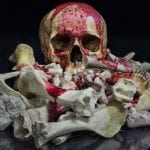 Weird Stuff
Weird Stuff  Weird Stuff
Weird Stuff  Mysteries
Mysteries 10 Tragic Disappearances and Deaths in Joshua Tree National Park
 History
History 10 Ways Childhood Really Sucked in the Old West
 Music
Music 10 Name Origins of Famous Bands from the 1990s
 Religion
Religion 10 Biggest Turnarounds by the Catholic Church
 Weird Stuff
Weird Stuff 10 Unbelievable Times Laws Had Unintended Consequences
 Humans
Humans Ten Historic Women Who Deserve Way More Credit Than They Got
 Movies and TV
Movies and TV 10 Films That Spawned Major Lawsuits
 History
History Ten Times Towns Were Wiped Off the Face of the Earth
 Creepy
Creepy 10 of the Most Disturbingly Haunted Public Houses in the UK
 Weird Stuff
Weird Stuff 10 Niche Subcultures That Are More Popular Than You Might Think
 Mysteries
Mysteries 10 Tragic Disappearances and Deaths in Joshua Tree National Park
 History
History 10 Ways Childhood Really Sucked in the Old West
Who's Behind Listverse?

Jamie Frater
Head Editor
Jamie founded Listverse due to an insatiable desire to share fascinating, obscure, and bizarre facts. He has been a guest speaker on numerous national radio and television stations and is a five time published author.
More About Us Music
Music 10 Name Origins of Famous Bands from the 1990s
 Religion
Religion 10 Biggest Turnarounds by the Catholic Church
 Weird Stuff
Weird Stuff 10 Unbelievable Times Laws Had Unintended Consequences
 Humans
Humans Ten Historic Women Who Deserve Way More Credit Than They Got
 Movies and TV
Movies and TV 10 Films That Spawned Major Lawsuits
 History
History Ten Times Towns Were Wiped Off the Face of the Earth
 Creepy
Creepy 10 of the Most Disturbingly Haunted Public Houses in the UK
10 Interesting Facts About Falling In Love From Modern Science
Falling in love can be one of the most mesmerizing, powerful, and life-altering experiences we can go through. It changes us both inside and out, on every level. We become radically different people with drastically changing outward behaviors when we fall in love, though it’s all too often fleeting, leaving us sobered and hungover when the rush of emotions subside, leaving us in the exact same place that we were before that magical someone came into our lives.
Valentine’s Day is only a few short weeks away, and love is in the air, on everyone’s mind, and hopefully in everyone’s hearts. But have you ever wondered about the nitty-gritty details of what we know as love? Just in time for V-Day, here are ten interesting facts about love from modern science.
10 Limerence

It all starts with the initial spark that turns into a massive blaze—the term for this is limerence. This is the flood of neurotransmitters that seemingly hijack our brains and cause us to stay up late into the night, talk to one another endlessly, think about each other 24 hours a day, and so on.
The interesting thing about limerence is that it’s believed that only certain people can actually cause it in us—that is, something about their composition.[1] Researcher John Gottman says, in his work Principia Amoris, that people have to smell and feel right and basically be just right in order to activate this flood of neurotransmitters in our brains. In other words, not everyone can do it for us, and it requires a certain makeup in an individual for it to happen. What these things are, at current, are beyond our understanding, but we know they have a material base to be found in.
9 Phenethylamine

Phenethylamine, also known simply as PEA, is a chemical compound that’s found in nature and produced in our brains. Phenethylamine hydrochloride, or Phenethylamine HCL, is a supplement version of the same chemical sold on the open market in many countries including the United States.[2] Phenethylamine is actually a nervous system stimulant, so if you ever wondered why you get so much energy around your love, this is exactly why—you might as well be on a dose of speed.
Pheromones are chemicals which are secreted by organisms to stimulate a response in other organisms. They’re how ants essentially talk to each other and how we communicate with one another on a sexual level (among others) without even saying a word. The two in combination serve as a powerful cocktail which serve as the initial chemicals involved in the cascading flood of emotions we feel as we begin to fall in love with someone. It’s all a ride from there.
8 Dehydroepiandrosterone

Dehydroepiandrosterone is also known as DHEA and is another powerful hormone involved in the brain when we begin to fall in love with someone. It’s both a steroid and a precursor hormone, which doesn’t do much by itself but can be converted to other hormones with much more powerful effects on our bodies.[3]
DHEA is a natural aphrodisiac which boosts our sexual desire and often performance and is also sold as an over-the-counter supplement for just this reason in many places. It also speeds us up on every level, including our immune system, which actually plays an interesting role in falling in love, as well as our memory, focus, and cognition.
7 Oxytocin

One of the most famous hormones involved in the whole process, oxytocin, is now being studied for its effects on the human brain, which have something to do with bonding and trust between individuals. Oxytocin does more than just soften our brains into a lovey-dovey mush; it also accompanies pregnancy and softens our skin.
Oxytocin actually changes the way we think of other people, making us think higher of others while also playing a role in how we decipher those we like from those we don’t like.[4] Oxytocin begins to flow in higher amounts leading up to and especially during sex, which helps us form a trusting bond with our partner. This effect lasts for several weeks for each lovemaking act and is especially strong in new, budding relationships.
6 Estrogen

Estrogen is not usually the hormone we think of when it comes to sex and dating, but it definitely plays a large role in the overall organic drug cocktail which floods our brain in a new relationship. Estrogen actually helps get us in the mood and activates in more significant quantities when we find someone attractive.
Estrogen is found in both men and women in different amounts (there are higher levels in women) and regulates mood, which highlights its pivotal role when it comes to falling in love and finding ourselves totally enamored by someone’s sheer presence.[5]
5 Vasopressin

Vasopressin is an extremely interesting hormone which plays a role in the monogamy part of pair-bonding, coming together and settling down.[6] This hormone is especially active in men. Vasopressin, in combination with oxytocin, triggers signals in our brains telling us to settle down and only mate with the one person who is the object of our affection.
Fascinating research in Sweden showed that the RS3 334 gene, which somehow modulates vasopressin receptors, can determine with a good bit of accuracy the level of commitment in men. The gene seems to be antithetical to men’s desires to settle down. Men can have one, two, or no copies of the RS3 334 gene. The study found that those who have two copies were more averse to monogamy and settling down, more likely to remain unmarried, and generally had much less committment and attachment to their partners, while men with no copies of the RS3 334 gene were the opposite, preferring marriage, commitment, and settling down to rampant flings or the single life. Men who had only one copy of the gene fell somewhere in the middle.
Our genetic makeup and hormone levels can heavily influence the process of falling in love and staying in love in some pretty interesting ways. So what do you think? Do you think our bodies entirely command us, that anatomy is destiny?
4 Lust

These chemicals in the brain come together to form what Dr. Helen Fisher, an anthropologist at Rutgers University, calls the three stages of love, which are lust, attraction, and attachment.[7] The process all begins with lust. Lust is basically characterized by high levels of testosterone and estrogen in the body, which create the breeding grounds for desire for other people; this part takes place without the need for a specific partner, and virtually any partner will do.
Chemicals are saturating the brain and telling it to go out and find partners, to mate and procreate, and to look for someone with whom it can move into the next stage of the mating process, much like a bacterium’s life cycle, which needs to transfer through stages in order to complete a cycle of procreation. So long as hindrances such as illness or other problems in our lives aren’t present, most of us operate on a base level of lust just about all the time to some extent, as the thought of finding a partner permeates virtually everything we do.
3 Attraction

Here’s where things start heating up between us and another person. The attraction phase is when we start to hone our sights in on one person in particular. We sometimes become obsessed, thinking about them all the time; this has also been described as the “infatuation phase,” and it’s extremely powerful. In this phase of the process, dopamine and adrenaline kick into overdrive, giving us a feeling of invincibility, all the while being flooded with a feeling of permanent energy, states that these two highly stimulating hormones can bring upon us.
Psychologists don’t dismiss this phase as unimportant like many often do. They say we actually need this part of the process in order to connect and bond with the person we’re slowly coming to settle down with. This is when our partner can do no wrong in an almost delusional sort of perception. “Love needs to be blind,” say psychologists, in order for it to work, and we need to see our partners as perfect and infallible, at least for a little while.[8] Many people are left disappointed when this phase wears off, but experts say that this very necessary phase should be enjoyed for what it’s worth and more importantly, its necessity as a bridge to the next phase.
2 Attachment

Attachment is the last part of the love cycle, when the cycle completes and we find ourselves bonding on the deepest level with our partner. The fuzzy chemicals of dopamine and adrenaline have subsided, replaced by oxytocin, “the cuddle chemical,” and vasopressin, “the monogamy hormone,” which tell us it’s time to relax and buy a minivan, maybe pop out a couple of kids.[9] It’s interesting to note that in some species of the animal kingdom, this phase is marked by “a mutual defense of territory,” which could poetically be applied to us human beings as well when we build our very human versions of the nest together.
In a sense, attachment is always present in our lives as an expression of love. In childhood, our family and friends are the ones we find ourselves attached to. This, of course, changes throughout our lifetime as different people enter and exit our lives and oftentimes culminates in the completion of the romantic love cycle. Then, attachment is bestowed upon our children if we choose to have them. Isn’t nature grand?
1 Internalization

Psychoanalyst Sigmund Freud was spot-on when he described the process of internalization in love, whereby we sort of augment the people we love and care about into ourselves, and they become a part of us.[10] Internalization is the really powerful part of romantic love which solidifies our bond further, albeit often completely unconsciously. At this point, a person’s beliefs, values, thoughts, actions, mannerisms, and more are adapted into us, and in the case of bilateral romantic love, ours into them.
This is when our attachment to a person has become so strong that we actually trade in little bits and pieces of ourselves for them, things about them that we find preferable to ours. 19th-century philosopher Friedrich Nietzsche saw this as a source of great power and our later character when he said:
All instincts that do not discharge themselves outwardly turn inward—this is what I call the internalization of man: thus it was that man first developed what was later called his “soul.”
What Nietzsche was trying to say here was that our core instinctual drives augment the important things, and if we don’t utilize them as fuel for our personal projects of life, they slowly become a part of us. In a very real way, through the process of internalization, two people who overlap create a single entity of ideas, thoughts, passions, hopes, and dreams with which they can build a future life.
Read more about love through the ages on 10 True Stories Of Love Found In Totally Unexpected Ways and 10 Bizarre Traditions Of Love That Are Lost In History.








